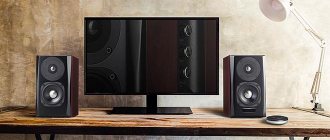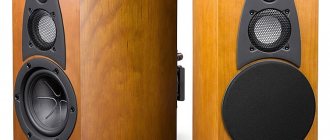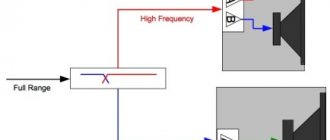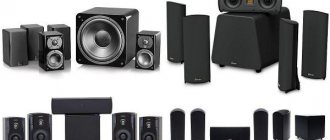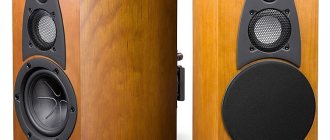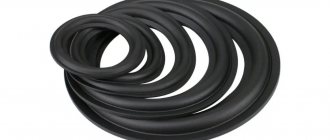Acoustic systems (or otherwise, speakers) are perhaps the most widely represented class of audio equipment today. There are hundreds of options on the market, and the process of choosing them is quite difficult. Therefore, we decided to write a small guide that can make solving this task easier.
Save and read later -
You can buy speakers for a hundred dollars, or you can buy them for a million. A frequency range of 10 octaves and a dynamic range of hundreds of decibels is the need to reproduce sound waves with lengths from centimeters to tens of meters and sounds from the deathly silence of an anechoic chamber to the thunderous roar of a jet aircraft. Even banal speaker enclosures range from “shoe boxes” to huge “cabinets” and from kilograms to centners.
Classification of acoustic systems by cost
Prices are per pair
First level
Floor stands up to 40,000 ₽ Shelves up to 15,000 ₽
Despite their declared initial status, speakers in this category can easily claim a key role in creating a full-fledged stereo system. A set based on them will play, at a minimum, significantly better than most music centers and wireless speakers, although the latter comes with a caveat, because these speakers can be several times more expensive than regular ones. It is probably not entirely correct to talk about some subtle musical matters in this category, but as for the frequency and dynamic range (in other words, different frequencies and different volumes), as well as the level of distortion, they will definitely be within the limits of what is permitted. They save here, most often, on appearance - for example, by replacing natural veneer with vinyl film, but its quality has recently increased significantly.
Budget level
Floor stands 40,000 – 80,000 ₽ Shelves 15,000 – 50,000 ₽
Budget-level speakers are such only in relation to their more expensive counterparts. As for their comparison with the initial models, in most cases they are already completely full-fledged acoustic systems. In relation to them, one can quite consciously consider such criteria as sound detail or sound stage construction - not to mention all the more familiar parameters. The economic factor may be present in the use of not the most expensive speakers from third-party manufacturers or in cases made of traditional materials (most often MDF), rather than exotic ones such as metal, wood or even glass.
Average level
Floor stands 80,000 – 160,000 ₽ Shelves 50,000 – 80,000 ₽
The average level is the same notorious golden mean, and its main feature is not at all in averaging objective parameters and subjective quality, but in achieving that bar, which, firstly, can only be overcome at much more significant costs, and secondly, Only a few avid music lovers - those same audiophiles - will be able to appreciate the excess. As for the vast majority of average buyers, for them this category is a reasonable maximum, and sometimes even the ultimate dream.
Premium level
Floor stands 160,000 – 500,000 ₽ Shelves 80,000 – 300,000 ₽
In the premium category, the most expensive components and technologies are used, various innovative solutions are used, literally the full potential of forces and means is used to ensure the highest possible sound quality, both in terms of objective parameters (the same amplitude and frequency range, phase unevenness and other distortions ), and from the standpoint of subjectively perceived sound quality, including the notorious involvement and musicality.
High End
Floor stands from 500,000 ₽ Shelves from 300,000 ₽
So what is High End audio and, strictly speaking, speakers in this category, as by and large the most obvious embodiment of this term? There is an opinion that sound quality that is close enough in feel can be achieved at lower costs. But the point is that the process of quality improvement in such terminal stages is purely non-linear. In other words, to do one tenth better, you may need to spend ten times as much. This time. And two: true High End is not only an absolute in terms of sound quality, but also an absolute absolute in terms of materials and technologies in relation to the manufacturer, which sometimes takes years, if not decades, to achieve.
There is an opinion that home speakers should be chosen solely based on price and visual appeal. However, even if you do not intend to become an expert in this matter, our article will help you easily reduce the number of “likely candidates” and discard obviously unacceptable options.
The sheer variety of speaker systems on the market makes the selection process a daunting task.
Stiffer and lighter
The efforts of the developers of speaker membranes are aimed at achieving one goal: increasing the rigidity of the diffuser and at the same time reducing its weight. If the diffuser is too heavy and too soft, it will not be able to accurately follow the movement of the magnetic coil. It simply does not have time to completely deflect and return, and bending vibrations give rise to overtones and additional coloration of the sound. In this case, it is highly desirable that the natural resonances be small or outside the operating frequency range.
The classic materials for making a diffuser are cellulose for low-frequency speakers and silk for high-frequency speakers. However, now, in addition to them, plastic, metal, and other exotics are actively used.
Diffuser design made using RDT II technology
Separately, it is worth noting hybrid designs: for example, when an aluminum polygonal one (ELAC Concentro AS-XR) is attached to a base made of a conventional paper cone. Another version of the “sandwich” is a honeycomb aramid with an inner layer of carbon fiber and an outer layer of aluminum and magnesium alloy with a ceramic coating (Monitor Audio Platinum RDT II). Compared to traditional “homogeneous” solutions, this “combined” diaphragm is lightweight, durable and able to respond faster to signals without deformation.
Manufacturer country
Audio equipment from different countries (and primarily acoustics) reproduces sound in different ways.
Let's say America is a country of big spaces, big cars and impressive sound systems. Such speakers are capable of “sounding” spacious American living rooms, and their appearance is striking in its monumentality. This trend is clearly illustrated by the Ultimate III model from Magico - after all, its height is less than 2.5 meters! And the sound matches the size: very dynamic, powerful, aggressive and assertive.
The Americans - the creators of Ultimate III - prefer large forms
In contrast, Japan, where small rooms provide a unique transfer function, on the contrary, tries to “dry out” the bass in its speakers. A typical example is the JBL Everest project, for which the famous reviewer Keizo Yamanaka was invited to supervise. As a matter of fact, the final sound was planned and turned out to be typically Japanese: the “external” attributes, the richness of timbres and the beauty of presentation are emphasized, sometimes on the verge of satiety and a subtle synthetic aftertaste - in other words, they do not sound entirely natural. As a result, today we do not have a single truly popular manufacturer of high-quality acoustics from the Land of the Rising Sun.
JBL DD55000 Everest is a great example of a “typically Japanese” approach to creating acoustics
Next - first of all the UK, with its B&W and Monitor Audio. The British sound is not sweeping or rollicking, but rather precise and restrained. This sound conveys the inner content of the music through some smooth and small gestures. It is believed that the “middle”, the most important part of the range, is handled especially well by English equipment.
“British sound” Monitor Audio Gold is appropriate even in a former church
Then Germany with their Canton and ELAC. The Germans are usually reproached for pedantry, reaching the point of sterility. In fact, their products clearly demonstrate meticulousness in relation to the details of musical composition and iron discipline in playback. The sound character is Nordic!
German precision is a big plus of ELAC acoustics from Germany
And last but not least – Denmark: a small country with great potential, a European leader in quantity, here it is appropriate to recall Dynaudio and System Audio. Proprietary solutions - many small speakers in narrow housings - make it possible to obtain a characteristic “fast” sound: instead of one heavy membrane of a large speaker, several small and light ones with an increased diffuser stroke are used. And the design of the cases, as a rule, is distinguished by the Scandinavian rigor known throughout the world.
Acoustics System Audio – speed, dynamics, power
Frequency range
The sound wave produced by a speaker has a frequency measured in Hertz (Hz). Human hearing detects sound in the range from 20 to 20,000 Hz. It is these values that manufacturers focus on when designing speaker systems.
The wider the range, the greater the range of sounds you can hear. Premium models have the best range: 20-35,000 Hz.
Dimensions
Which is better - big or small?
Nowadays, when choosing the “caliber” of speaker systems, you should be guided rather by the dimensions of the room. I would call the 20 m² area the “Rubicon” between shelf and floor solutions.
Although, with a competent approach to the issue, floor-standing speakers can easily get along at 15 meters, but in a 10-meter office or bedroom, I would strongly recommend limiting yourself to a shelf stereo pair.
First of all, you should take into account the geometry and acoustic properties of the room in which the speakers will be installed. A room can be large, but empty and echoing, and large speakers with full-size bass will create a real cacophony in it. At the same time, a relatively small room can provide conditions for comfortable listening.
The second important factor is the placement of the speakers: at a minimum, you should not place them too close or far from each other, close to the wall, and especially not in the corners. The optimal design is an equilateral triangle consisting of a listener and a pair of speaker systems.
| As the old saying goes, all speakers are divided into good and bookshelf (just kidding). In fact, if you asked me when exactly bookshelf speaker systems began to be perceived as full-fledged participants in the process, I would say 1974, which saw the release of two iconic models - the LS3/5 minimonitors and the large Yamaha NS-1000 bookshelf speakers. The first is a plywood case with the dimensions of a shoe box and a pair of plastic speakers, the issue price at the time of release is a hundred pounds per pair, the destination is BBC mobile television studios. This model, perhaps, holds the record for the number of subsequent clones and homages. The second are full-size three-way bookshelf speakers weighing more than 30 kg and with beryllium (!) diffusers, the most famous and almost the only successful model from the Japanese company Yamaha. |
| In multi-band systems The spectrum of all audible frequencies is divided into several overlapping bands. The range of each band is fed to a separate speaker, which has the best performance in that range. In this way, the highest quality reproduction of human-audible sound frequencies is achieved. Three-way scheme includes low-frequency, mid-frequency and high-frequency speakers. |
Wilson Audio Tiny Tot in 1985 and Sonus faber Extrema in 1991, it seems to me, secured the full status of shelf models.
Rating
So, now you know how to choose speakers wisely, taking into account their parameters and characteristics. We present a rating of the best home models with optimal parameters and good reviews.
Edifier R980T
A small stereo pair of speakers (2.0) has an output power of 24 W and a front bass reflex. The acoustics are designed for tabletop placement. The speakers are perfect for a computer. The body is made of MDF in a stylish black color. The equipment looks expensive and solid.
The model has a frequency range of 70-20000 Hz and a class D digital amplifier. The speakers are designed using a 2-way design, based on 4-inch bass speakers. On the back of the case there are toggle switches for adjusting the reproduced volume and bass level.
pros
- stylish design;
- there are settings on each column;
- good, strong bass;
- clear sound, no hissing or wheezing;
- inexpensive.
Minuses
- the switch is at the back, it’s not always convenient to reach for it;
- few high frequencies;
- Not very high quality wires.
From 3300 ₽
Edifier R12U
The Edifier R12U model is a practical choice of speakers for a tablet or computer.
Small but powerful speakers squeeze out a total of 4 watts. On the front panel of the acoustics there is a bass reflex and a toggle switch. The body is made of plastic and comes in 3 colors: red, black, white. The range of reproduced frequencies of the speakers is 180-20000 Hz. The speakers are connected via a USB connector. The model also has a mini jack linear output and a headphone jack.
pros
- light, compact;
- there are controls on the front of the case;
- very good bass;
- absolutely silent when inactive;
- cheap.
Minuses
- at maximum volume they may wheeze a little (depending on the music);
- glossy plastic gets dirty quickly;
- If you use it for a long time and at loud volumes, they get very hot.
From 900 ₽
SVEN SPS-820
The 2.1 speaker system in an elegant design has a total output power of 38 W. A distinctive feature of the model is the possibility of desktop and wall placement. The body is made of MDF, which has a positive effect on sound quality. The range of reproduced frequencies is 20-20000 Hz. On the front of the case there are controls through which you can adjust the treble and bass. The bass reflex on the subwoofer significantly enhances the bass.
The sound quality of this acoustics will please both computer game lovers and music lovers.
pros
- clear, high-quality sound on all ranges;
- high level of strength, last a very long time;
- very high quality casing that does not wear out over time;
- very powerful volume, glass may rattle in a small room;
- possibility of adjusting bass and treble;
- no noise from mobile phone.
Minuses
- short wires.
From 3500 ₽
Amplifier selection
Since we mentioned matching the speakers with the room, let's also decide on such a criterion as matching the speakers with the amplifier. Do you want to be honest? In most cases, there are simply no obvious signs of such consistency or inconsistency. Of course, “you cannot harness a horse and a tremulous doe to one cart”:
- You should not connect a speaker with a sensitivity higher than 90 decibels to a solid amplifier with a power of several kilowatts.
- You shouldn't try to drive a 500-watt floor-standing speaker with an integrated amplifier with 50 watts of output.
So is high power needed to “drive” such acoustics?
But I don’t mean such trivial cases at all, but a fairly common question: “Tell me, here on the speakers it says “X Watts”, and on the amplifier it says “Y Watts”. Does this mean they are not suitable for each other? This means absolutely nothing.
For an amplifier, long-term or short-term output power for a certain load is indicated.
For speakers, the power consumption can be indicated, continuously or at peak.
And from the point of view of reliability: you will be very surprised, but you are more likely to burn out your speakers with a cheap, low-power amplifier, whose distortion in overload mode will lead to breakdown.
Having identified several suitable options for yourself, make your final choice after a test listening
What is a column with a flash drive
A speaker with a flash drive is a portable audio device that runs on batteries or rechargeable batteries. Thanks to this, it is very mobile, which allows you to take the device with you and listen to music anywhere.
What is a portable speaker and how does it transmit sound?
A speaker with a flash drive is a compact audio device, which in appearance is very similar to a regular radio. Despite its small size, it is capable of providing fairly loud sound. Of course, its sound quality will be lower than that of stationary acoustics, but much higher than that of a smartphone. The sound itself depends on certain parameters.
Let's summarize
The principles described will help you choose several speaker models that are most suitable for you. And the final choice of the “very, very” suitable acoustics is best made based on the listening results. Don’t be lazy, stop by your nearest salon and listen for yourself.
And not so much a consultant as a technician. If the certainty with the dimensions and manufacturer of your potential speakers did not bring satisfaction and left too many options to choose from, in the second part of this article we will try to deal with the purely technical side of the issue.
Continuation: Part two - about speakers
Prepared based on materials from the Barnsly Blog portal, December 2017
blog.barnsly.ru
This article was read 32,503 times
The article is included in the sections:
How to choose. Buyer's Guide


